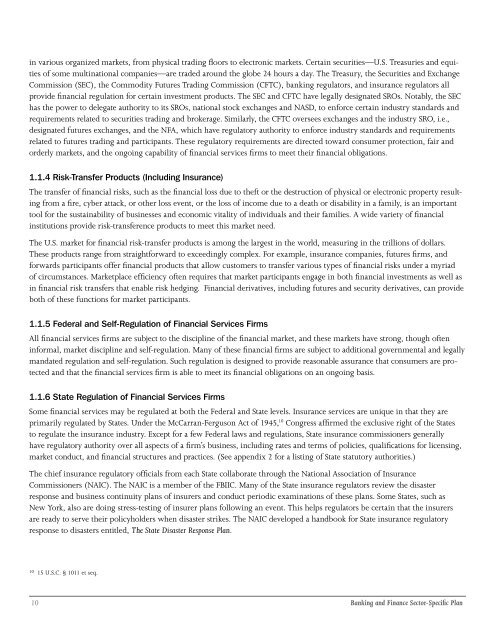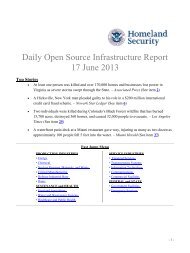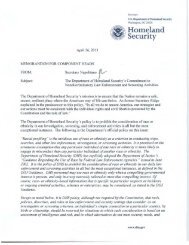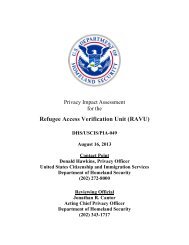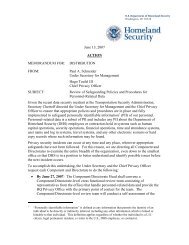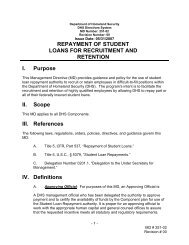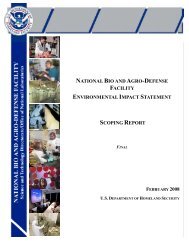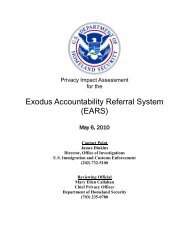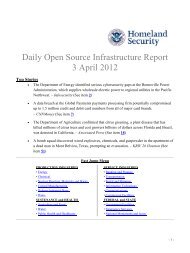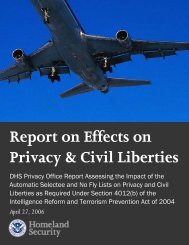Banking and Finance Sector-Specific Plan - U.S. Department of ...
Banking and Finance Sector-Specific Plan - U.S. Department of ...
Banking and Finance Sector-Specific Plan - U.S. Department of ...
Create successful ePaper yourself
Turn your PDF publications into a flip-book with our unique Google optimized e-Paper software.
in various organized markets, from physical trading floors to electronic markets. Certain securities—U.S. Treasuries <strong>and</strong> equities<br />
<strong>of</strong> some multinational companies—are traded around the globe 24 hours a day. The Treasury, the Securities <strong>and</strong> Exchange<br />
Commission (SEC), the Commodity Futures Trading Commission (CFTC), banking regulators, <strong>and</strong> insurance regulators all<br />
provide financial regulation for certain investment products. The SEC <strong>and</strong> CFTC have legally designated SROs. Notably, the SEC<br />
has the power to delegate authority to its SROs, national stock exchanges <strong>and</strong> NASD, to enforce certain industry st<strong>and</strong>ards <strong>and</strong><br />
requirements related to securities trading <strong>and</strong> brokerage. Similarly, the CFTC oversees exchanges <strong>and</strong> the industry SRO, i.e.,<br />
designated futures exchanges, <strong>and</strong> the NFA, which have regulatory authority to enforce industry st<strong>and</strong>ards <strong>and</strong> requirements<br />
related to futures trading <strong>and</strong> participants. These regulatory requirements are directed toward consumer protection, fair <strong>and</strong><br />
orderly markets, <strong>and</strong> the ongoing capability <strong>of</strong> financial services firms to meet their financial obligations.<br />
1.1.4 Risk-Transfer Products (Including Insurance)<br />
The transfer <strong>of</strong> financial risks, such as the financial loss due to theft or the destruction <strong>of</strong> physical or electronic property resulting<br />
from a fire, cyber attack, or other loss event, or the loss <strong>of</strong> income due to a death or disability in a family, is an important<br />
tool for the sustainability <strong>of</strong> businesses <strong>and</strong> economic vitality <strong>of</strong> individuals <strong>and</strong> their families. A wide variety <strong>of</strong> financial<br />
institutions provide risk-transference products to meet this market need.<br />
The U.S. market for financial risk-transfer products is among the largest in the world, measuring in the trillions <strong>of</strong> dollars.<br />
These products range from straightforward to exceedingly complex. For example, insurance companies, futures firms, <strong>and</strong><br />
forwards participants <strong>of</strong>fer financial products that allow customers to transfer various types <strong>of</strong> financial risks under a myriad<br />
<strong>of</strong> circumstances. Marketplace efficiency <strong>of</strong>ten requires that market participants engage in both financial investments as well as<br />
in financial risk transfers that enable risk hedging. Financial derivatives, including futures <strong>and</strong> security derivatives, can provide<br />
both <strong>of</strong> these functions for market participants.<br />
1.1.5 Federal <strong>and</strong> Self-Regulation <strong>of</strong> Financial Services Firms<br />
All financial services firms are subject to the discipline <strong>of</strong> the financial market, <strong>and</strong> these markets have strong, though <strong>of</strong>ten<br />
informal, market discipline <strong>and</strong> self-regulation. Many <strong>of</strong> these financial firms are subject to additional governmental <strong>and</strong> legally<br />
m<strong>and</strong>ated regulation <strong>and</strong> self-regulation. Such regulation is designed to provide reasonable assurance that consumers are protected<br />
<strong>and</strong> that the financial services firm is able to meet its financial obligations on an ongoing basis.<br />
1.1.6 State Regulation <strong>of</strong> Financial Services Firms<br />
Some financial services may be regulated at both the Federal <strong>and</strong> State levels. Insurance services are unique in that they are<br />
primarily regulated by States. Under the McCarran-Ferguson Act <strong>of</strong> 1945, 10 Congress affirmed the exclusive right <strong>of</strong> the States<br />
to regulate the insurance industry. Except for a few Federal laws <strong>and</strong> regulations, State insurance commissioners generally<br />
have regulatory authority over all aspects <strong>of</strong> a firm’s business, including rates <strong>and</strong> terms <strong>of</strong> policies, qualifications for licensing,<br />
market conduct, <strong>and</strong> financial structures <strong>and</strong> practices. (See appendix 2 for a listing <strong>of</strong> State statutory authorities.)<br />
The chief insurance regulatory <strong>of</strong>ficials from each State collaborate through the National Association <strong>of</strong> Insurance<br />
Commissioners (NAIC). The NAIC is a member <strong>of</strong> the FBIIC. Many <strong>of</strong> the State insurance regulators review the disaster<br />
response <strong>and</strong> business continuity plans <strong>of</strong> insurers <strong>and</strong> conduct periodic examinations <strong>of</strong> these plans. Some States, such as<br />
New York, also are doing stress-testing <strong>of</strong> insurer plans following an event. This helps regulators be certain that the insurers<br />
are ready to serve their policyholders when disaster strikes. The NAIC developed a h<strong>and</strong>book for State insurance regulatory<br />
response to disasters entitled, The State Disaster Response <strong>Plan</strong>.<br />
10 15 U.S.C. § 1011 et seq.<br />
0<br />
<strong>Banking</strong> <strong>and</strong> <strong>Finance</strong> <strong>Sector</strong>-<strong>Specific</strong> <strong>Plan</strong>


